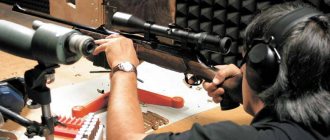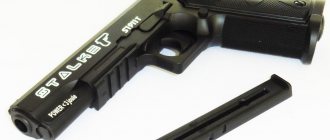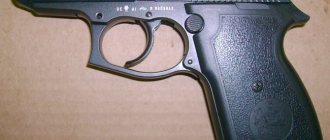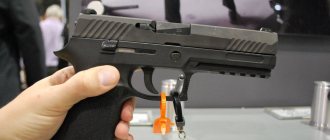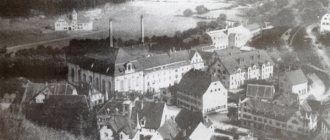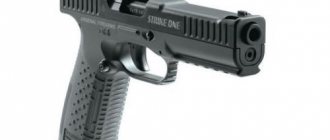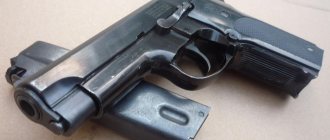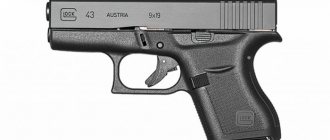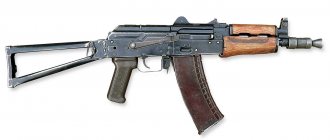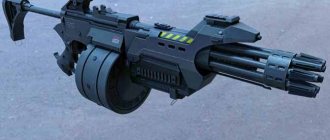| SIG P226 | |
| Type | gun |
| A country | Germany, Switzerland |
| Service history | |
| Years of use | 1983–present |
| Production history | |
| Designed by | 1981 |
| Manufacturer | SIG Sauer |
| Years of production | 1983[1] |
| Options | DAK, SAS, Equinox, Two-Tone, 226R, SL Sport II, Stainless, Beavertail, Elite, Navy, E2 |
| Characteristics | |
| Weight, kg | 802 g (9x19 mm Parabellum) 867 g (.357 SIG and .40 S&W) |
| Length, mm | 196 mm |
| Barrel length, mm | 112 mm |
| Cartridge | *9x19mm Parabellum *.40 S&W *.357 SIG (depending on model) |
| Work principles | recoil with a short barrel stroke, double/single or double action trigger mechanism |
| Type of ammunition | magazine for 12 or 13 rounds (.40 S&W, .357 SIG) or 15,17,18,20 rounds (9×19 mm Parabellum) |
| Media files on Wikimedia Commons | |
SIG Sauer P226
is a pistol produced by the Swiss-German company of the same name. The SIG Sauer P226 was developed in 1981 as a weapon for the US military.
A more compact modification of the P226 is called the SIG Sauer P228, and its improved (in terms of the ability to fire cartridges other than 9x19 mm, except for the E2 version) successor, the Sig Sauer P229.
Design and options
The automatic pistol operates on the principle of recoil of the barrel during its short stroke. Locking is carried out using a descending barrel, engaging the upper protrusion of its breech with an enlarged window of the shutter-casing for ejecting spent cartridges. The reduction occurs when the inclined plane of the barrel tide interacts with the axis of the barrel lock. The trigger mechanism is double-action, with a safety cocking mechanism. There are various USM options. Descent with warning. The weapon has a safety release lever located on the left side of the frame. When you press this lever, it goes down, raising the sear, and disengages it from the cocking slot. Under the influence of the mainspring, the hammer rotates until the safety cocking slot engages the sear without contact with the firing pin, which makes the weapon convenient and safe to use. The pistol is equipped with an automatic firing pin safety. On the left side of the frame there is also a bolt stop lever, located behind the safety trigger lever, and a barrel lock. The magazine release is located at the base of the trigger guard.
Currently, many variants of the standard P226 are produced, best suited for certain tasks, for example:
- The P226 DAK differs from a standard pistol in that it only has a self-cocking trigger mechanism and does not have a safety release lever.
- P226 SAS is a pistol produced by the Custom Shop, with smoothed corners of the slide-casing for the convenience of concealed carry, equipped only with a self-cocking trigger. Caliber - .40 S&W. Magazine capacity - 12 rounds
- The P226 Equinox is also a weapon from the Custom Shop with a two-tone surface treatment of the bolt-casing and wooden grip cheeks. Other characteristics remain the same
- The P226 Two-Tone features an anodized alloy frame and a stainless steel slide body.
- P226R, that is, R-rail, which allows you to attach a laser laser or tactical flashlight
- There are also variants of the P226: SL Sport II, Stainless, Beavertail, Elite, Navy, as well as E2 (see below).
- P226 X5
- P226 X6
In February 2010, Sauer SIG, the American representative of the Swiss firearms manufacturer Swiss Arms AG, announced the release of a new pistol, the E2 (e-squared) P226.
It is distinguished from previous versions by improved ergonomics (E2 literally stands for Enhanced Ergonomics). The new model of the SIG pistol is distinguished by a monolithic handle structure and improved surface textures. This made it possible to reduce the size of the rear part of the handle and generally provide greater comfort when shooting the pistol.
The SIG E2 P226 model is chambered for the 9×19 Parabellum cartridge with a nitron finish (the nitron finish of the case is a special development of Sauer SIG, the distinctive characteristics of which are high wear resistance, corrosion protection and anti-reflective coating)
[2]
Pistols SIG and SIG-Sauer (Switzerland-Germany)
On the eve of World War II, the Swiss military department announced a competition to replace the out-of-date Parabellum pistol, developed by G. Lugger back in 1900. According to the requirements finally formulated by 1938, the new pistol had to have the usual 9× caliber 19 mm (Parabellum cartridge), but superior to its predecessor in combat characteristics. During selection tests, the Swiss military tried many foreign models of pistols, but none of them (even the Belgian “Hi Power”) met their requirements. However, this was understandable, because the requirements for small arms in the Swiss army are among the most stringent in the world.
Pistol SIG P 210
At the beginning of 1939, it was decided to create our own pistol model. SIG specialists took on the task of implementing the order, but the war that began soon and the devastation that followed delayed its execution. It was only in 1949 that a new pistol was introduced to the Swiss military. It was a semi-automatic pistol, built according to the scheme with an engaged bolt and a short barrel stroke, developed by J. Browning back in 1897. In principle, it was a licensed version of the pistol of Charles Petter, the chief designer (SACM) from Cholet. The Petter pistol under the designation MAS M 1935 was produced before and during World War II by French companies for the needs of the French army and the Wehrmacht.
During testing, the new Swiss pistol showed excellent results in all combat parameters. In terms of shooting accuracy, he had no equal at all. An experienced shooter, armed with a new pistol, could “put” all 8 cartridges in his magazine into a circle with a diameter of 50 mm from a distance of 25 m. This was the uniqueness of the pistol created by SIG specialists - being essentially an army pistol, In terms of shooting accuracy, it was quite consistent with the best examples of sporting weapons.
In 1949, a new pistol under the designation P 49 (pistol model 1949) was adopted into service in Switzerland. For quite a long time it was rightfully considered the most accurate and one of the most reliable, but at the same time the most expensive army pistol. But, apparently, its price parameters did not really bother real connoisseurs of high-quality small arms. In the early 50s. XX century it was put into service in Denmark and, according to some reports, was purchased to arm special forces personnel in West Germany.
Pistol SIG P 220
In European countries, the P 49 pistol is better known under the designation P 210 and goes on sale in several versions, differing mainly in finishing, barrel length (in sports models its length reaches 150 mm) and sights. At the same time, the base model 9 mm pistol can be easily converted to use the 7.65×19 “Parabellum” cartridge by simply replacing the barrel. In addition, it is possible to use .22 LR (5.6 mm) caliber cartridges to fire the P 210, but this will require replacing the barrel, bolt, recoil spring and magazine.
In 1975, the Swiss army adopted a new pistol, the P 75 (pistol model 1975), known in European countries under the designation “SIG-Sauer” P 220. Despite this, its predecessor remained in service almost until the end of the twentieth century. was in service in Denmark, and in Switzerland itself and many European countries even in the 21st century. is one of the most popular sports pistols of the 20th century, was in service in Denmark, and in Switzerland itself and many European countries even in the 21st century, it is one of the most popular sports pistols.
Read: Smith & Wesson Revolver
In the mid-60s. XX century specialists from the Swiss company SIG began developing a new model of an army pistol. According to the company's management, it had to meet the increased requirements for modern small arms and replace the SIG P 210 (P 49) pistol, which had been in service since 1949.
In 1972, Switzerland passed a law that significantly limited the production of military weapons in the country, and most importantly, their export. Under these conditions, in order to continue work on a new pistol, the management of SIG decided to create a joint venture with a German armory, known for producing one of the best Wehrmacht pistols, the P 38 H, during World War II. The product of such cooperation was a pistol, traditionally designated P 220 From its predecessor, the P 210 pistol, which had proven itself to be a highly accurate, reliable, but at the same time quite expensive weapon, the P 220 differed in a casing-bolt made by stamping from steel, an aluminum alloy frame and more modern external shapes. The automatics of the new pistol were built according to the well-proven scheme of J. Browning with a linked bolt and a short barrel stroke, which was successfully tested in the P 210 pistol. In general, design and technological innovations made it possible to somewhat reduce the cost of producing the pistol and at the same time preserved it high technical and firing characteristics.
Pistol SIG P 225
In 1975, the P 220 pistol was successfully tested and was adopted by the army and police units of Switzerland under the less common designation P 75 (pistol model 1975). Following this, it was adopted into service in Japan, Austria, France and a number of other European countries. In the press you can find information about the use of the P 220 pistol by US police officers and intelligence agents of various countries. In addition, the P 220 pistols, designed for commercial use, are successfully sold in more than 50 countries around the world. Due to strict export rules adopted in Switzerland, such pistols are produced in Germany at , but, according to experts, their quality does not decrease because of this.
The high popularity of the P 220 pistol all over the world, even despite its rather high cost, is largely due to the traditional Swiss quality applied to weapons and a fairly developed model range. First of all, this concerns the production of pistols designed to use cartridges of various calibers. The basic model P 220 was designed for the European 9¹19 “Parabellum” cartridge. Following this, a model was released designed to use a 7.65x22 mm small-caliber cartridge. To expand beyond the European market, SIG, together with specialists from JP Sauer & Sohn GmbH, developed and launched the production of pistols of “American” standards. After simple modifications to the base model, production of pistols chambered for .38 ACP (9 mm) and .22 LR (5.6 mm) cartridges began. The biggest change made to the basic design of the pistol was the relocation of the magazine release button, which was located at the bottom of the grip on European models, to the base of the trigger guard. A more significant modernization (this mainly affected technology) required the transfer of the pistol to the 11.43 mm caliber (.45 ACP cartridge).
At the end of the twentieth century. production of P 220 pistols was discontinued. However, according to some information, in America, a model designed to use the .45 ACP cartridge continued to be produced even at the beginning of the 21st century.
At the end of the 70s. XX century specialists from the Swiss-German joint venture SIG-Sauer have begun developing a new pistol intended for arming the police and army. As a basis, it was decided to use one of the pistols previously produced. In 1980, a new pistol was presented, which received the company’s traditional designation P 225.
Read: German fighter Pfalz D.VII
In fact, it was a compact modification of the well-proven P 220 pistol of the same company. Like the base model of its prototype, the P 225 pistol was designed for distribution on the European market and therefore at the initial stage was produced only in the 9x19 “Parabellum” cartridge.
The automatic operation of the new pistol was built according to a well-proven scheme with a short stroke of the barrel engaged with the bolt, used on almost all SIG models. Minor design changes affected only the fastening of the shutter to the frame and the shape of individual parts of the shutter. In addition, the pistol received additional safety devices for firing only when the trigger is deliberately pressed. Having lost almost 10% in all main dimensions, the P 225 pistol has become convenient for concealed carry. At the same time, the pistol retained the positive qualities inherent in Swiss weapons - high shooting accuracy and reliability. It is therefore not surprising that in the same year that the P 225 was first introduced to the general public, it was adopted by the German Bundeswehr (under the designation P 6), as well as many police departments in Switzerland and Germany. Following this, the pistol found fans among officers of the self-defense forces and armies of Japan, Thailand, Nigeria, Switzerland, Denmark, France and some other countries (mostly European).
In order to expand the geography of sales of the P 225 pistol, which was primarily limited to its European caliber, the management of SIG-Sauer decided to start producing pistols of this brand, adapted to American standards. A few years later, a new version of the pistol appeared, received the index P 226, combining design elements of P 220 and P 225. It was produced in three versions, designed to use 9x19 “Parabellum”, .357 SIG cartridges (own development of the Swiss concern SIG , made on the basis of a cartridge case from .40 “Smith & Wesson”, in which the muzzle is compressed under a 9 mm caliber bullet) and .40 “Smith & Wesson” (10 mm).
In the mid-80s. XX century P 226 took part in special tests organized by the US military department in order to determine a model capable of replacing the Colt M 1911 pistol, which had been in service with the American army since 1911. As expected, the Swiss-German pistol demonstrated very good firing characteristics. In terms of shooting accuracy, the weapon left far behind almost all competitors and perfectly met American standards. Together with the Italian Beretta M 92 F, the P 226 pistol reached the finals. And although almost all the technical parameters of the pistols were equal, the lower purchase price of the Beretta determined the fate of the new American army pistol. Nevertheless, the relative high cost did not prevent the P 226 from finding fans where the reliability and quality of weapons are put in first place. This is evidenced by the fact that in America the pistol was adopted by the FBI, and in the UK by the elite special forces of the SAS.
Pistol SIG P 228
The high popularity of the P 220 series pistols prompted specialists from the Swiss company SIG to create a compact pistol based on them, which would have the same characteristics and modern design. In 1989, the development of the new pistol was completely completed. By tradition, it received the designation P 228, which emphasized its belonging to the now popular P 220 series of pistols. The production of the P 228 pistol was organized at German arms factories. As with all previous models of pistols in the P 220-P 226 series, this choice of the manufacturer was associated with restrictions on the export of weapons in force in Switzerland.
Read: Design of the P-96 S pistol
The automatics of the new pistol were built according to a well-proven design scheme, successfully used in pistols of the P 210 and P 220 series. Like its prototype, the P 228 was designed to use European 9x19 “Parabellum” cartridges. At the same time, the new pistol was 18 mm shorter than the P 220, and the magazine capacity increased to 13 rounds. The pistol frame, made of aluminum alloy, has become more streamlined for ease of holding and quick removal of the pistol when carried concealed under clothing. The ambidextrous arrangement of the main controls made the P 228 pistol equally convenient for use by right-handed and left-handed shooters. When listing the advantages of the new compact pistol, you should pay attention to its elegantly shaped handle and an unusually short trigger, which allow a person with small hands to use the weapon without much effort (which is practically not found in other brands of modern pistols). According to experts, all the changes made to the design of the pistol did not affect its excellent firing properties, inherent in all pistols of the P 220-P 226 series, and the production of the P 228 in German factories did not affect the quality traditional for Swiss weapons. Probably, it was these indicators that influenced the increased interest that arose in the compact P 228 in many countries around the world. In particular, the company received an order to produce a large batch of pistols for US police and special forces. In the early 90s. XX century The process of converting the pistol to the American standard began. First of all, this affected the redesign of its design for .375 SIG (9 mm) and .40 “Smith & Wesson” (10 mm) cartridges. In order for the shooter to safely use these high-power cartridges, which develop significant pressures in the barrel when fired, SIG specialists had to change the design of the bolt of the “American” pistol. If the P 228 bolt was made by simple stamping from sheet steel, then for a pistol designed to use high-power cartridges, it had to be milled from a single piece of steel. This changed the design and manufacturing technology of the P 228 pistol so much that its developers considered it possible to assign its own designation to its “American” modification - P 229. At the same time, at the initial stage of production (pistols were produced in Germany at) P 228 were transformed into P 229 by installation of new barrels and bolts on a standard frame. Therefore, early P 229 pistols have one remarkable quality that their later modifications lack (production of P 229 pistols was soon transferred to America to ): “American” pistols in .375 SIG and .40 Smith & Wesson calibers can be easily converted from one caliber to another, as well as to European ones by simply replacing barrels.
Since 1992, on the American continent, the P 229 has been recognized as one of the most popular service pistols, which are distinguished by SIG’s traditional high reliability, excellent accuracy, and ease of use. For these qualities, the P 229 was adopted by the American police, FBI and various special forces. In the same year, Swiss pistols even managed to somewhat displace the Italian Beretta M 92 FS, which is in service with the US Army. The P 229 pistols, called M 11, began to be equipped with aircraft and helicopter crew members, as well as US Air Force personnel who needed a more compact and lightweight weapon.
You might be interested:
- Pistol GSh-18 (Russia)
- Pistols “Le Français”, MAB, MAS M 1935 and “Unique” (France)
- Pistols MP-443 “Grach”, OTs-27 “Berdysh” and SR-1 “Gyurza” (Russia)
- Pistol "Sauer" 38 H (Germany until 1945)
- Pistol "Beretta M92"
- Shpagin submachine gun
Subscribe to
our channel in Yandex.Zen
Operating countries
P226 is used in various countries, including Europe and the USA.
- USA USA - Since 1988[1], these weapons have been purchased by the FBI, Coast Guard and various police departments. It is also in service with the NAVY SEALs special forces.
- Israel Israel - some purchased in the late 1980s - early 1990s; in the late 1990s, some of the P-226s, which were in service with IDF special forces, were replaced with Glock-17s[3]
- Indonesia Indonesia - a certain number in service with commandos (groups of combat swimmers "Komando Pasukan Katak" and special forces "Komando Pasukan Khusus")[4]
- Kazakhstan Kazakhstan - since 2007 certified as a service weapon[5]
- Poland Poland - a certain number is in service with the special forces "Formoza" of the Polish Navy[6]
- Russia Russia - since 2010[7], a certain quantity has been purchased by the Russian Practical Shooting Federation as a sporting weapon[8]
- and others
Notes
- ↑ 123
Sig Sauer P226 (series). armory-online.ru. - New SIG E2 (e-squared) pistols in the P226 and P229 line - Arms Encyclopedia (inaccessible link - history
). Retrieved October 12, 2013. Archived October 15, 2013. - Alex Reznikov. IDF small arms - pistols and revolvers Archived April 28, 2020. // website “War Online”, August 28, 2002
- Igor SPICIJARIĆ. Kopassus & Kopaska - Specijalne Postrojbe Republike Indonezije Archived August 22, 2010. // magazine “Hrvatski Vojnik”, No. 161, 2007
- “ Registration number: 3.1/006 Service pistol SIG SAUER P226
” Resolution of the Government of the Republic of Kazakhstan No. 1305 of December 28, 2006 “On approval of the State Cadastre of civilian and service weapons and ammunition for them for 2007” - Nowe pistolety dla WP // “Altair” dated December 8, 2011
- Mikhail Degtyarev. Began? Continues... 9-mm pistols in the FSPR arsenal // Kalashnikov magazine. Weapons, ammunition, equipment", No. 5, 2010. pp. 50-52
- Mikhail Degtyarev. Pistol history // Kalashnikov magazine. Weapons, ammunition, equipment", No. 8, 2011. pp. 30-33
| SIG Sauer P226 on Wikimedia Commons |
story
Not to be confused with the SIG P210 series, which was licensed by the Petter-Browning system from SACM France in 1938. The SIG Sauer P220 was designed for release in 1975 to the Swiss Army as a replacement for the SIG P210 which was developed during World War II; in service it is known as the "pistol 75" (P75). For industrial production and distribution of the P220, SIG partnered with JP Sauer & Sohn of Germany, thus the P220 and all subsequent pistols from SIG and JP Sauer & Sohn are properly known as Sig Sauer
pistols.
In 1975, Switzerland became the first country to officially adopt the P220 as the "Pistole 75" (P75) chambered in 9mm Parabellum. Other countries to accept it for military use include Japan (general issue) and Denmark (which has the earlier P210 in general issue) special forces only. It followed the SIG Sauer P226, which included a dual stack magazine.
Upon completion of military service, all soldiers can obtain ownership of their sacramental weapons for a nominal fee; in particular, officers and soldiers of the medical forces of the Swiss Armed Forces can obtain ownership of their P220 service pistols by paying an administration fee of thirty Swiss francs.
In the United States, this pistol was originally sold in a modified form as the Browning BDA from 1977 to 1980.
